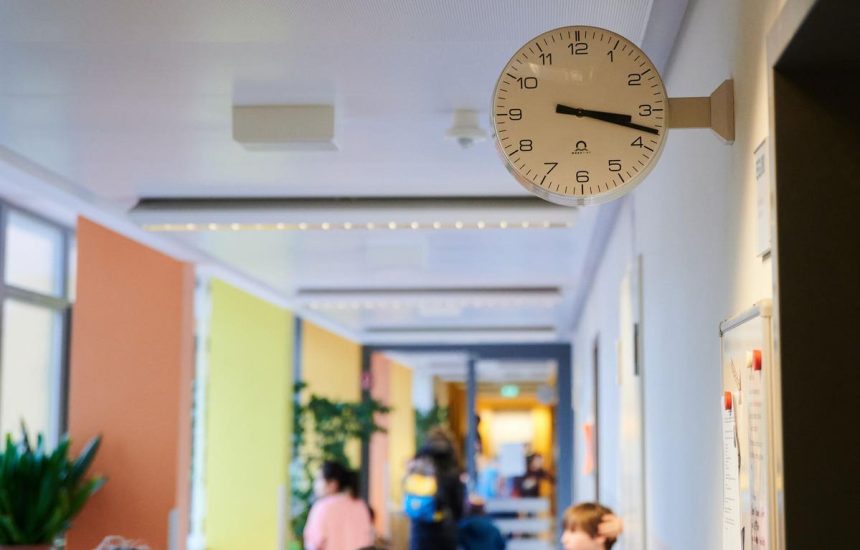As the new school year gets underway, there’s a lot of talk about programs, technology, and staffing challenges. But one opportunity for school improvement seems to consistently get overlooked: time.
Three decades ago, the National Education Commission on Time and Learning observed, “Learning in America is a prisoner of time. For the past 150 years, American public schools have held time constant and let learning vary. The rule, only rarely voiced, is simple: learn what you can in the time we make available.”
And yet there’s little attention to just what gets done with the time schools already have. As I suggest in The Great School Rethink, the way out of this dilemma starts not by adding time but by making better use of the time we have.
Advocates and public officials routinely argue that our kids need more time in school. As I’ve noted before, though, the reality is that American students actually spend about 100 hours more in school each year than their peers in other advanced economies. This doesn’t mean that American students necessarily get enough schooling. But it suggests that simply boosting the number of hours kids sit in school may be the wrong goal.
If students spend more time in school than one might guess, why does it feel like there’s never enough time? It’s because too much time gets lost and wasted.
In 2021, in a far-too-unusual study of schools in Providence, Rhode Island, researchers Matt Kraft and Manuel Monti-Nussbaum documented just how many disruptions there are in the course of a school day. They estimated that a typical Providence classroom is interrupted over 2,000 times per year, with interruptions adding up to 10 to 20 days of instructional time. Major disruptions included intercom announcements, staff visits, and students entering class in troublesome ways, with most interruptions leading to spillover disruptions. Administrators underestimated the frequency of disruptions and the time they consumed.
The reality is that lots of time spent in school doesn’t necessarily translate into lots of learning. In 2015, researcher Sam Abrams took a high school in Holyoke, Massachusetts, with 180 days in its academic calendar, and started ticking off lost time. There were seven early-release days for professional development, eight days for exams, and another seven mornings set aside for the Massachusetts state test (all classes were paused on these mornings even though only tenth graders took the state exam).
When all was said and done, the analysts estimated that total instructional time in this school during a given year added up to just 62 percent of the 1,076 hours estimated by OECD. That means more than 400 hours were devoted to stuff other than instruction. That 1,076-hour year turns into a 670-hour year.
While all of this can tell us important things about how much instruction students receive, it still can’t say much about whether those students are actually engaged. That’s a problem because tuned-out students aren’t learning—whether or not they’re sitting in classrooms.
As it turns out, a lot of students spend most of their school time feeling bored and disengaged. The High School Survey of Student Engagement reports that four out of five public high school students say they’re sometimes bored in class and half say they’re often bored. Students also tend to say that they’re less engaged as they get older. Gallup has reported that four in five elementary students said they were engaged in school, a ratio that fell to three in five middle schoolers and just two in five high schoolers.
Think about it this way: if students are engaged 60 percent of the time, a 30-hour instructional week amounts to more like eighteen hours of actual learning. A 1,080-hour school year becomes a 650-hour school year (and our 670-hour “actual” instructional year shrinks to 420 hours). In short, boosting engagement could potentially dwarf the benefits of a longer school year. Heck, less time in school could conceivably yield more actual learning time—if less time in class meant students were more engaged.
There are many ways to make fuller use of educational time. They may include more schools incorporating hybrid homeschooling, more extended learning time, more nontraditional models, more virtual learning, more apprenticeships, or much else.
But all of them should begin with parents, policymakers, and practitioners focusing on four simple questions. First, where is time going? Second, how do we reduce wasted time? Third, which uses of time are most valuable? And, fourth, how do we spend more time on the stuff that’s valuable and less on everything else?
When it comes to how schools use time, parents and educators can inevitably recall some school leader who squeezed out recess or music to add more test prep—and they justifiably fear that talk of using time better is being driven by some false notion of “efficiency.” That has things exactly backward.
The point is to have kids spend less time doing busy work, staring at screens, or counting down the minutes to dismissal. The right response to demands for more time should not be to cut back on recess or race to lock students in school for extra hours or extra weeks. It should be to first figure out how to make the most of the time schools already have.
Read the full article here










